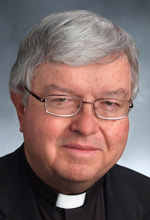Q. The church that we attend has front-row seating for disabled members of the congregation, and that is where my husband and I sit. At Communion time, the host is always brought to us at our seats.
However, many times the ministers of the cup forget us and we don’t have the opportunity to receive the precious blood of Jesus. I don’t know the rules on who can receive from the chalice; I would be very grateful for an explanation in your column, in case other parishes are doing the same. (Appleton, Wisconsin)
A. Sometimes I choose a question for the value of the question itself, as well as for the answer. Such is the case here. Your question serves as a reminder that the same consideration must always be given to people with disabilities as to other members of the congregation.
When the congregation is offered the opportunity to receive the Eucharist under both species, that same privilege should be accorded to parishioners who are disabled. The U.S. Conference of Catholic Bishops in 2002 issued norms for the distribution and reception of holy Communion under both kinds, saying that receiving under both species was the norm for the first millennium of the church’s existence and more clearly fulfills Christ’s invitation to “take and eat … take and drink.”
[hotblock]
The norms cautioned that when the chalice is used, there should be “no danger of the profanation of the sacrament.” Special care should therefore be taken that the precious blood not be spilled, but that should not be an issue when those who are disabled are seated in a convenient location (in your case, in the first row of seats.)
Q. The Gospel that is read on the feast of the Assumption has always puzzled me. How are we to know that these words were actually spoken by Mary? Did she relate them to Luke at a later time? (To further my confusion, my St. Joseph Sunday Missal says that Mary’s song of thanksgiving, often called the Magnificat, has been put together from many Old Testament phrases.)
Can you please shed some light on this? (Indianapolis)
A. Luke was a careful historian. Much more than the other Gospel writers, he intertwines the life and ministry of Jesus with events in the wider world. At the start of Chapter 3, for example, he begins his account of the preaching of John the Baptist by identifying the political leaders at the time in five different jurisdictions.
Luke also focuses more than the other evangelists on the experiences of Mary, the mother of Jesus. Luke alone tells of Mary’s surprise at the message of the angel Gabriel, the visit to her cousin Elizabeth, the presentation of the Lord in the temple and the anxious time of separation in Jerusalem when Jesus was 12.
Mark and John begin their Gospels at the start of Christ’s public life. Matthew, though he includes an account of Christ’s birth, uses far less detail than Luke. Luke even includes a glimpse into Mary’s thinking (Lk. 2:19): “Mary kept all these things, reflecting on them in her heart.”
Where did Luke get all of this information? Well, right at the outset he explains (in Lk. 1:2) that he is relying on the testimony of “those who were eyewitnesses from the beginning.” Might one of those witnesses have been Mary herself? Though no one knows for certain, that is a possibility.
Luke was a gentile, a physician from Antioch in Syria. He was a companion of Paul on his missionary journeys and arrived in Jerusalem about the year 57. Mary might still have been alive, though by then she would have been in her 70s.
Another possibility is that Luke took his information about Mary from James, the leader of the church in Jerusalem. (James is described in Galatians 1:19 as “the brother of the Lord,” perhaps the son of Joseph from an earlier marriage.)
As for your concern about the use of Old Testament phrases in Mary’s Magnificat, Mary would have been steeped as a child in the Hebrew Scriptures, and it would have been no surprise for her spontaneous song of praise to incorporate words from Scripture.
In fact, Mary’s Magnificat bears striking parallels to the hymn of Hannah (1 Sm. 2) when Hannah learns that she will bear a child.
***
Questions may be sent to Father Kenneth Doyle at askfatherdoyle@gmail.com and 40 Hopewell St., Albany, N.Y. 12208.
PREVIOUS: Delving the links of divorce, forgiveness and annulments
NEXT: Pope says Gospel brings new life, new freedom; don’t fear change




Share this story